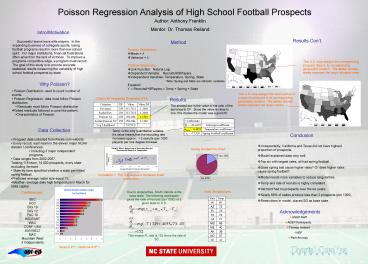Poisson Regression Analysis of High School Football Prospects - PowerPoint PPT Presentation
1 / 1
Title:
Poisson Regression Analysis of High School Football Prospects
Description:
AZ. 81. HI. Temp. State. This means FL rate is 152 times the rate of SD. State Temperatures ... This U.S. map assigns the total number of prospects produced to its ... – PowerPoint PPT presentation
Number of Views:239
Avg rating:3.0/5.0
Title: Poisson Regression Analysis of High School Football Prospects
1
Poisson Regression Analysis of High School
Football Prospects
Poisson Regression Analysis of High School
Football Prospects
Author Anthony Franklin Mentor Dr. Thomas
Reiland
Intro/Motivation
Results Cont.
Method
Successful teams have elite players. In the
expanding business of collegiate sports, losing
football programs result in more than low school
spirit. For major institutions, financial
frustrations often arise from the lack of
victories. To improve a programs competitive
edge, a program must recruit. The goal of this
study is to provide accurate statistical results
measuring the variability of high school football
prospects by state.
- Poisson Distribution
- Mean ?
- Variance ?
- Poisson Regression
- Link Function Natural Log
- Dependent Variable Recruits/HSPlayers
- Independent Variables Temperature, Spring, State
- Note Spring and State are indicator variables
- Equation
- Y Recruits/HSPlayers Temp Spring State
This U.S. map assigns the corresponding prospect
rates to its corresponding geographic location.
The darker shaded states represent the larger
prospect rates.
Why Poisson?
- Poisson Distribution- used to count number of
events. - Poisson Regression- data must follow Poisson
distribution - Residuals must follow Poisson distribution
- Plotted residuals followed a cone like pattern.
- Characteristics of Poisson.
This U.S. map assigns the total number of
prospects produced to its corresponding
geographic location. The darker shaded states
represent the larger values.
Results
Criteria for Assessing Goodness of Fit
The shaded box is the value of the ratio of the
deviance to DF. Since the value is close to one,
this implies the model was a good fit.
Data Collection
Temp. is the only quantitative variable. Its
value means that the recruiting rate increases
approx. 1.5 recruits (per 1000 players) per one
degree increase.
Conclusion
- Prospect data collected from Rivals.com website.
- Every recruit, each team in the eleven major
NCAA division I conferences. - Including 3 major independent programs.
- Data ranges from 2002-2007.
- Totaling 118 team, 14,000 prospects, every state
excluding Vermont. - State by-laws specified whether a state
permitted spring football. - Predicted average roster size equal 75.
- Weather- average daily high temperature in March
for state capital.
- Unexpectedly, California and Texas did not have
highest proportion of prospects. - Model explained data very well.
- Top six with largest rates, all had spring
football. - Does spring ball cause higher rates? Or does
higher rates cause spring football? - Model needs more variables to reduce
singularities. - Temp and rate of recruits is highly correlated.
- Vermont had no prospects over the six years.
- Nearly 68 of states produce less than 2
prospects (per 1000). - Restrictions in model, placed SD as base state.
Spring Football Pie Chart
Correlation .758, this implies a moderate
linear relationship.
State Temperatures
Conferences
Due to singularities, South Dakota is the base
state. The following expression gives the ratio
of recruits (per 1000) of a given state to S D.
SEC ACC BIG 10 BIG 12 PAC 10 BIG EAST WAC CONF.
USA SUN BELT MAC Mountain West 3 Independents
Acknowledgements
- AGEP Staff
- AGEP Participants
- Thomas Reiland
- NSF
- Pam Arroway
This means FL rate is 152 times the rate of SD.
Texas is 4th!! California is 6th!!































